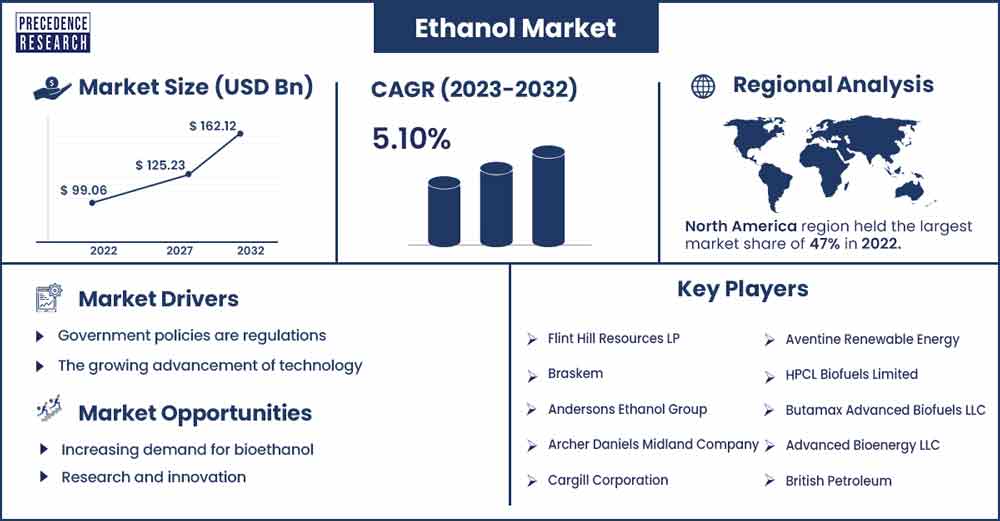November 2025
The global ethanol market size reached USD 99.06 billion in 2022 and is projected to hit USD 162.12 billion by 2032, growing at a CAGR of 5.10% from 2023 to 2032.

Ethanol, also known as ethyl alcohol, is a type of alcohol that is commonly used as a recreational beverage, a fuel, and an industrial solvent. Ethanol is a biofuel that helps in reducing greenhouse gas emissions and reduces dependency on traditional fuels. Growing penetration towards the usage of material as a biofuel is driving the demand for ethanol.
Increasing government initiatives in order to move towards renewable energy along with rising environmental concerns are proliferating the growth of the market. Moreover, rising development of infrastructure, stringent emissions regulations, and advancement in biofuel production are some of the key factors adding to the market growth.
North America acquired the most prominent share. The growth of the region is attributed to stringent regulations towards the reduction of fossil fuels. Growing demand from the food processing industry is also one of the major contributors to the industry's growth. Moreover, the governments of various economies including the United States, and Canada are focusing on the reduction of fossil fuels and carbon footprints. According to the US Department of Energy, the majority of ethanol generated in the US comes from starch-based crops processed in either a dry or wet mill. Owing to their cheaper initial expenditures, dry mills account for over 90% of ethanol facilities.
The United States is one of the largest producers and consumers of ethanol globally. Ethanol is primarily produced from corn in the U.S. The Renewable Fuel Standard (RFS) program, administered by the Environmental Protection Agency (EPA), has been a significant driver of ethanol production. The RFS mandates the blending of biofuels, including ethanol, into the nation's fuel supply.
| Report Coverage | Details |
| Market Revenue in 2023 | USD 103.62 Billion |
| Projected Forecast Revenue by 2032 | USD 162.12 Billion |
| Growth Rate from 2023 to 2032 | CAGR of 5.10% |
| Largest Market | North America |
| Base Year | 2022 |
| Forecast Period | 2023 to 2032 |
| Regions Covered | North America, Europe, Asia-Pacific, Latin America, and Middle East & Africa |
Drivers
Government policies are regulations
Rising levels of pollution along with increasing environmental concerns due to the usage of traditional fuel are driving the demand for ethanol. Many countries have implemented policies mandating the use of biofuels, including ethanol, to reduce greenhouse gas emissions and enhance energy security. These mandates can significantly drive the demand for ethanol. Government support through subsidies, tax credits, and other financial incentives can encourage both ethanol production and consumption. Moreover, the regulatory push towards the production of bioethanol. Rising awareness regarding carbon footprints and the use of alternative fuels are driving the market growth.
Technological advances
The growing advancement of technology is driving the demand for sustainable fuel. Various investments are taken by the government in order to promote biofuels. Ongoing advancements in biofuel production technologies can lead to more efficient and cost-effective ethanol production, making it a more attractive option in the market. Improvements in biotechnology can enhance the efficiency of ethanol production from feedstocks such as corn, sugarcane, and cellulosic materials. Moreover, consumer awareness of environmental issues and a preference for cleaner and renewable fuels can drive demand for ethanol-blended fuels. Global trade policies and agreements can influence the cross-border movement of ethanol and impact market dynamics.
Restraints
Government regulations
Government regulations and policies play a significant role in the ethanol market. Changes in regulations related to biofuels, blending mandates, and subsidies can impact the demand and profitability of ethanol. Additionally, trade policies and tariffs can affect international ethanol markets. Moreover, many countries have implemented ethanol blend mandates, requiring a certain percentage of ethanol to be blended with gasoline.
Compliance with these mandates can be challenging for both fuel producers and distributors, especially if there are fluctuations in the supply and cost of ethanol. Environmental laws apply to the production and use of ethanol, especially with regard to greenhouse gas emissions and land usage. Regulations intended to lessen biofuels' negative environmental effects may provide difficulties for the ethanol sector.
Environmental concerns
While ethanol is considered a renewable and cleaner alternative to traditional fuels, there can be debates and concerns regarding the environmental impact of large-scale ethanol production, such as land-use changes and the overall carbon footprint of the entire production process. Moreover, public perception and acceptance of ethanol as a fuel can influence its demand. Lack of awareness, concerns about engine compatibility, and misconceptions about the environmental benefits of ethanol can hinder its adoption.
Opportunities
Increasing demand for bioethanol
The demand for renewable fuel is experiencing significant growth owing to the implementation of supportive policies by the government. Governments of various economies are promoting the production of bioethanol. Increasing research and development expenditure in order to focus on enhancing the production process, and efficiency are expected to create lucrative opportunities in the market. Moreover, as countries aim to reduce their dependence on non-renewable energy sources, there's a growing demand for biofuels, creating opportunities for ethanol producers.
Research and innovation
Ongoing research and development in the field of biofuels may lead to advancements in ethanol production processes, making it more efficient and cost-effective. Companies investing in research and innovation can position themselves for success in the evolving market. Moreover, researchers are also exploring advanced technologies for the production of ethanol from various feedstocks, including cellulosic biomass such as agricultural residues forestry waste, and algae. Cellulosic ethanol production processes aim to make ethanol production more efficient and sustainable.
Market Segmentation
By Source
By Purity
By Application
Buy this Research Report@ https://www.precedenceresearch.com/checkout/1188
You can place an order or ask any questions, please feel free to contact at sales@precedenceresearch.com | +1 650 460 3308
November 2025
October 2025
July 2025
July 2025